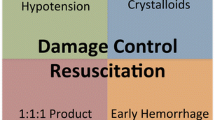Abstract
Damage control resuscitation is a comparatively recent concept that has developed from military experience in warfare. It has been successfully used in both conflict surgery and in civilian settings in patients with severe injuries, where the emphasis is placed on targeting physiological rather than anatomical restoration, with multiple shorter staged procedures replacing one longer operation. It is not a universally required approach for all patients, but those who are the most unstable as a result from injuries have the most to gain from this approach. While the historical approach to damage control has been focused on surgical approaches, there are several non-surgical interventions which fit with this paradigm of care. A shared understanding of this approach and its application is essential for success, as it requires all team members to understand the ultimate end goal and methodology.
Access this chapter
Tax calculation will be finalised at checkout
Purchases are for personal use only
Similar content being viewed by others
References
Toghil G. The Battle of Jutland: The Largest Naval Clash of World War One [Internet]. History Hit. 2019 [cited 2019 June 19]. Available from: https://www.historyhit.com/the-battle-of-jutland-the-largest-naval-clash-of-world-war-one/
Bergeron DL. Fighting for Survival: USS Yorktown (CV5) Damage Control Experiences in 1942 [Internet]. University of New Orleans; 2016 [cited 2019 June 19]. Available from: https://scholarworks.uno.edu/cgi/viewcontent.cgi?article=3224&context=td
Brohi K. TRAUMA.ORG: Damage Control Surgery [Internet]. trauma.org. 2000 [cited 2019 June 19]. Available from: http://www.trauma.org/archive/resus/DCSoverview.html
Roberts DJ, Ball CG, Feliciano DV, Moore EE, Ivatury RR, Lucas CE, et al. History of the innovation of damage control for management of trauma patients: 1902–2016. Ann Surg. 2017;265(5):1034–44.
Pringle JH. Notes on the arrest of hepatic hemorrhage due to trauma. Ann Surg. 1908;48(4):541–9.
Stone HH, Strom PR, Mullins RJ. Management of the major coagulopathy with onset during laparotomy. Ann Surg. 1983;197(5):532–5.
Rotondo MF, Schwab CW, McGonigal MD, Phillips GR, Fruchterman TM, Kauder DR, et al. ‘Damage control’: an approach for improved survival in exsanguinating penetrating abdominal injury. J Trauma. 1993;35(3):375–82. discussion 382–383
Johnson JW, Gracias VH, Schwab CW, Reilly PM, Kauder DR, Shapiro MB, et al. Evolution in damage control for exsanguinating penetrating abdominal injury. J Trauma. 2001;51(2):261–9. discussion 269–271
Malbrain MLNG, Roberts DJ, Sugrue M, De Keulenaer BL, Ivatury R, Pelosi P, et al. The polycompartment syndrome: a concise state-of-the-art review. Anaesthesiol Intensive Ther. 2014;46(5):433–50.
Huang Q, Li J, Lau W. Techniques for abdominal wall closure after damage control laparotomy: from temporary abdominal closure to early/delayed fascial closure—a review [Internet]. Gastroenterol Res Pract 2016 [cited 2019 Aug 2]. Available from: https://www.hindawi.com/journals/grp/2016/2073260/
Zakrison T, Nascimento BA, Tremblay LN, Kiss A, Rizoli SB. Perioperative vasopressors are associated with an increased risk of gastrointestinal anastomotic leakage. World J Surg. 2007;31(8):1627–34.
Scalea TM. Optimal timing of fracture fixation: have we learned anything in the past 20 years? J Trauma Injury Infect Crit Care. 2008;65(2):253–60.
Roberts CS, Pape H-C, Jones AL, Malkani AL, Rodriguez JL, Giannoudis PV. Damage control orthopaedics: evolving concepts in the treatment of patients who have sustained orthopaedic trauma. JBJS. 2005;87(2):434.
Sikorski RA, Koerner AK, Fouche-Weber LY, Galvagno SM. Choice of general Anesthetics for trauma patients. Curr Anesthesiol Rep. 2014;4(3):225–32.
Mercer SJ, Whittle CL, Mahoney PF. Lessons from the battlefield: human factors in defence anaesthesia. Br J Anaesth. 2010;105(1):9–20.
Buckenmaier C, Mahoney PF, United States, Borden Institute (US), editors. Combat anesthesia: the first 24 hours. Falls Church, Virginia: Fort Sam Houston, Texas: Office of the Surgeon General, United States Army; Borden Institute; 2015. 571 p. (TMM series).
Penn-Barwell JG, Roberts SAG, Midwinter MJ, Bishop JRB. Improved survival in UK combat casualties from Iraq and Afghanistan: 2003–2012. J Trauma Acute Care Surg. 2015;1
Deakin CD. Scoop and run versus stay and play: strategies in pre-hospital care. In: Gullo A, editor. Anaesthesia, Pain, Intensive Care and Emergency Medicine — APICE [Internet]. Milano: Springer Milan; 2003 [cited 2019 July 23]: [1019–26 pp.]. Available from: http://link.springer.com/10.1007/978-88-470-2215-7_31
Smith RM, Conn AKT. Pre-hospital care - scoop and run or stay and play? Injury. 2009;40(Suppl 4):S23–6.
Reid C, Brindley P, Hicks C, Carley S, Richmond C, Lauria M, et al. Zero point survey: a multidisciplinary idea to STEP UP resuscitation effectiveness. Clin Exp Emerg Med. 2018;5(3):139–43.
Mutschler M, Nienaber U, Münzberg M, Wölfl C, Schoechl H, Paffrath T, et al. The shock index revisited – a fast guide to transfusion requirement? A retrospective analysis on 21,853 patients derived from the TraumaRegister DGU®. Crit Care. 2013;17(4):R172.
Petrosoniak A, Hicks C. Resuscitation resequenced: a rational approach to patients with trauma in shock. Emerg Med Clin North Am. 2018;36(1):41–60.
Damme CD, Luo J, Buesing KL. Isolated pre-hospital hypotension correlates with injury severity and outcomes in patients with trauma. Trauma Surg Acute Care Open [Internet]. 2016 Aug 12 [cited 2019 July 24];1(1). Available from: https://www.ncbi.nlm.nih.gov/pmc/articles/PMC5891702/
Codner P, Obaid A, Porral D, Lush S, Cinat M. Is field hypotension a reliable indicator of significant injury in trauma patients who are normotensive on arrival to the emergency department? Am Surg. 2005;71(9):768–71.
Lemer C, Cheung R, Klaber R, Hibbs N. Understanding healthcare processes: how marginal gains can improve quality and value for children and families. Arch Dis Child Educ Pract. 2016;101(1):31–7.
Pentecost C, Richards DA, Frost J. Amalgamation of marginal gains (AMG) as a potential system to deliver high-quality fundamental nursing care: a qualitative analysis of interviews from high-performance AMG sports and healthcare practitioners. J Clin Nurs. 2018;27(11–12):2387–402.
Author information
Authors and Affiliations
Corresponding author
Editor information
Editors and Affiliations
Rights and permissions
Copyright information
© 2022 The Author(s), under exclusive license to Springer Nature Switzerland AG
About this chapter
Cite this chapter
Lax, P. (2022). Initial Approach to Damage Control Resuscitation. In: Lax, P. (eds) Textbook of Acute Trauma Care . Springer, Cham. https://doi.org/10.1007/978-3-030-83628-3_14
Download citation
DOI: https://doi.org/10.1007/978-3-030-83628-3_14
Published:
Publisher Name: Springer, Cham
Print ISBN: 978-3-030-83627-6
Online ISBN: 978-3-030-83628-3
eBook Packages: MedicineMedicine (R0)




